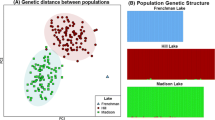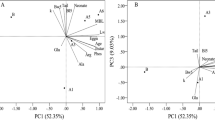Abstract
In the mountain range of South Norway, transparent and melanic members of the Daphnia longispina complex occur. Melanic populations inhabit clearwater lakes and ponds, while transparent populations are found in ponds with slightly humic water. Mixed populations have not been detected. The distribution patterns of the two morphs are related to ambient levels of short-wave radiation, and the light absorptive properties of the inhabited waters. The pigment present is probably melanin, which is deposited in the dorsally directed parts of the carapace, head shield and antennae. Allozyme studies indicate that these distinct morphs are only remotely related, the alpine transparent group being closer to lowland, likewise transparent, populations. A melanic population found at Svalbard is closely related to the melanic mainland populations. Clonal diversity in ponds and shallow lakes is very low, in contrast to populations of deeper lakes.
Similar content being viewed by others
References
Ayala, F. J., M. L. Tracey, L. C. Barr, J. F. McDonald & S. Perez-Salas, 1974. Genetic variation in natural populations of five Drosophila species and the hypothesis of the selective neutrality of protein polymorphism. Genetics 77: 343–384.
Beaton, M. J. & P. D. N. Hebert, 1989. Geographical parthenogenesis and polyploidy in Daphnia pulex. Am. Nat. 132: 837–845.
Bottrell, H. H., A. Duncan, Z. M. Gliwicz, E. Grygierik, A. Herzig, A. Hillbricht-Ilkowska, H. Kurasawa, P. Larsson & T. Weglenska, 1976. A review of some problems in zooplankton production studies. Norw. J. Zool. 24: 419–456.
Brehm, V., 1938. Die Rotfarbung von Hochgebirgseeorganismen. Biol. Rev. 13: 307–318.
Britton, G., 1983. The biochemistry of natural pigments. (Cambridge texts in chemistry and biochemistry). Cambridge University Press.
Brooks, J. L., 1957. The systematics of North American Daphnia. Mem. Connect. Acad. Arts. Sci. 13: 1–180.
Dodson, S. I., 1984. Predation of Heterocope septentrionalis on two species of Daphnia: Morphological defenses and their cost. Ecology 65: 1249–1257.
Ekman, S., 1904. Die Phyllopoden, Cladoceren und freischwebenden Copepoden der nordschwedischen Hochgebirge. Ein Beitrag zur Tiergeographie, Biologie und Systematik der arktischen, nordschwedischen und mitteleuropäischen Arten. Zool. Jb. Syst. Ökol. Geogr. Tiere 21: 1–170.
Emery, C. J., 1984. The ecological impact of near ultraviolet radiation on Daphnia pulex. MSc thesis, University of Windsor, Ontario.
Felsenstein, J., 1987. PHYLIP (Phylogeny Inference Package) version 3.0 Manual. Univ. of Washington.
Ferrari, D. C. & P. D. N. Hebert, 1982. The induction of sexual reproduction in Daphnia magna: genetic differences between arctic and temperate populations. Can J. Zool. 60: 2143–2148.
Flößner, D., 1972. Krebstiere, Crustacea. Kiemen- und Blattfüßer, Branchiopoda; Fischläuse, Branchiura. Die Tierwelt Deutschlands, 60. Teil: 1–501. G. Fischer, Jena.
Flößner, D., 1986. Beitrag zur Kenntnis der Branchiopoden- und Copepodenfauna der Mongolei. Mitt. Zool. Mus. Berl. 62: 3–40.
Frey, D. G., 1982. G. O. Sars and the Norwegian Cladocera: a continuing frustration. Hydrobiologia 96: 267–293.
Hairston, N. G., Jr., 1976. Photoprotection by carotenoid pigments in the copepod Diaptomus nevadensis. Proc. natn. Acad. Sci. 73: 971–974.
Hairston, N. G., Jr., 1978. Carotenoid photoprotection in Diaptomus kenai. Verh. int. Ver. Limnol. 20: 2541–2545.
Hairston, N. G., Jr., 1979. The adaptive significance of colour polymorphism in two species of Diaptomus (Copepoda). Limnol. Oceanogr. 24: 38–44.
Hebert, P. D. N., 1974. Enzyme variability in natural populations of Daphnia magna. III. Genotypic frequencies in intermittent populations. Genetics 77: 335–341.
Hebert, P. D. N., 1987. Genotypic characteristics of the Cladocera. Hydrobiologia 145: 183–193.
Hebert, P. D. N. & T. J. Crease, 1983. Heterosis in Daphnia: a reassessment. Am. Nat. 119: 427–434.
Hebert, P. D. N. & J. M. Loaring, 1980. Selective predation and the species composition of arctic ponds. Can. J. Zool. 58: 422–426.
Hebert, P. D. N. & D. B. McWalter, 1983. Cuticular pigmentation in arctic Daphnia: adaptive diversification of asexual lineages. Am. Nat. 122: 286–291.
Hebert, P. D. N., R. D. Ward & L. J. Weider, 1988. Clonal-diversity patterns and breeding system variation in Daphnia pulex, an asexual-sexual complex. Evolution 42: 147–159.
Herring, P. J., 1965. Blue pigment of a surface-living oceanic copepod. Nature 205: 103–104.
Hobæk, A. & G. G. Raddum, 1980. Zooplankton communities in acidified lakes in South Norway. SNSF project, IR 75/80. Oslo-Aas, Norway: 1–132.
Hrbáček, J., 1987. Systematics and biogeography of Daphnia species in the northern temperate region. Mem. Ins. ital. Idrobiol. 45: 37–76.
Hrbáček, J., V. Korínek & D. G. Frey, 1978. Cladocera. In J. Illies (ed.), Limnofauna Europaea (2. ed.). G. Fisher Verlag, Stuttgart: 189–195.
Innes, D. J. & P. D. N. Hebert, 1988. The origin and genetic basis of obligate parthenogenesis in Daphnia pulex. Evolution 42: 1024–1035.
Korpelainen, H., 1986. The effect of temperature and photoperiod on life history parameters of Daphnia magna (Crustacea: Cladocera). Freshw. Biol. 16: 615–620.
Lilljeborg, W., 1887. Contributions to the natural history of the Commander Islands. No. 9. On the Entomostraca collected by Mr. Leonhard Stejneger, on Bering Island, 1882–'83. Proc. U.S. Nat. Mus. 10: 154–156.
Lilljeborg, W., 1901. Cladocera Sueciae. Nova Acta Soc. Reg. Sc. Ups. Ser. 3 Vol. 19. 701 pp.
Luecke, C. & W. J. O'Brien, 1981. Phototoxicity and fish predation: Selective factors in color morphs of Heterocope. Limnol. Oceanogr. 26: 454–460.
Margaritora, F. & O. Ferrara, 1979. Contributo alla conoscenza di Daphnia rosea Sars (Cladocera Daphnidae) in Italia: confronti e differenze con D. longispina O.F. Müller e D. zschokkei Stingelin. Boll. Mus. Civ. St. Nat. Verona 6: 127–138.
Nauwerck, A., 1978. Bosmina obtusirostris im Latnjajaure. Arch. Hydrobiol. 82: 387–418.
Nei, M., 1972. Genetic distance between populations. Am. Nat. 106: 283–292.
Pejler, B., 1973. On the taxonomy of limnoplanktic Daphnia species in Northern Sweden. Zoon 1: 23–27.
Sars, G. O., 1890. Oversigt af Norges Crustaceer med foreløbige Bemærkninger over de nye eller mindre bekjendte Arter. II. (Branchiopoda-Ostracoda-Cirripedia). Forh. Vidensk.-Selsk. Christiania 1890 No. 1: 1–80.
Siebeck, O., 1978a. Ultraviolet tolerance of planktonic crustaceans. Ver. int. Ver. Limnol. 20: 2469–2473.
Siebeck, O., 1978b. UV-toleranz und Photoreaktivierung bei Daphnien aus biotopen verschiedener Hohenregion. Naturwissenschaften 65: 390–391.
Stingelin, T., 1894. Über zwei neue Daphnien aus dem schweizerischen Hochgebirge. Zool. Anz. 17: 378–380.
Thomasson, K., 1956. Reflections on arctic and alpine lakes. Oikos 7: 117–143.
Weider, L. J., 1989. Spatial heterogeneity and clonal structures in arctic populations of apomictic Daphnia. Ecology 70: 1405–1413.
Weider, L. J., M. J. Beaton & P. D. N. Hebert, 1987. Clonal diversity in high-arctic populations of Daphnia pulex, a polyploid apomictic complex. Evolution 41: 1335–1346.
Weider, L. J. & W. Lampert, 1985. Differential response of Daphnia genotypes to oxygen stress: respiration rates, hemoglobin contents and low oxygen tolerance. Oecologia 65: 487–491.
Wolf, H. G., 1982. A comparison of different electrophoretic techniques for the detection of isoenzymes in single daphniids. Arch. Hydrobiol. 95: 521–531.
Wolf, H. G., 1987. Differences in the genetic structure of pond-dwelling and lake-dwelling Daphnia. Verh. int. Ver. Limnol. 23: 2056–2059.
Wolf, H. G. & A. Hobæk, 1986. Ecological genetics of Norwegian Daphnia I. Genetic differentiation between pigmented and unpigmented alpine pond populations. Hereditas 104: 193–198.
Zaret, T. M., 1980. Predation and freshwater communities. Yale University Press, New Haven & London. 187 pp.
Author information
Authors and Affiliations
Additional information
Deceased.
Rights and permissions
About this article
Cite this article
Hobæk, A., Wolf, H.G. Ecological genetics of Norwegian Daphnia. II. Distribution of Daphnia longispina genotypes in relation to short-wave radiation and water colour. Hydrobiologia 225, 229–243 (1991). https://doi.org/10.1007/BF00028401
Issue Date:
DOI: https://doi.org/10.1007/BF00028401




